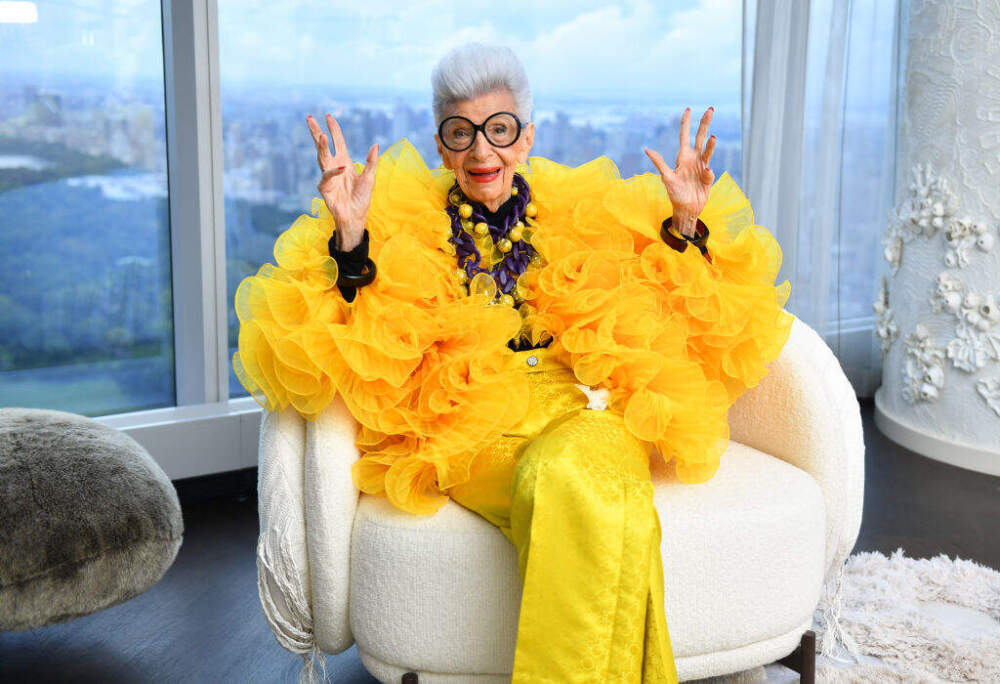Advertisement
Commentary
'Are you a gal or a mouse': Iris Apfel changed my sartorial life

Iris Apfel — a fashion icon like none other — died on March 1 at the age of 102. The obituaries and testimonials were laudatory, affectionate and larded with more breathless adjectives than raisins in a fruitcake.
I never met the woman in the flesh, but I did spend a couple of hours in 2009 with a selection from the contents of her amazing closet.
It was a freezing, damp, overcast New England winter day, the kind of day where the existence of the sun is purely theoretical. I was dressed for the weather: parka down to my calves, gloves and hat — all in shades of black.
I looked like a shadow or a ghoul. And so did virtually every other woman crowded into the Peabody Essex Museum to view “Rare Bird of Fashion: The Irreverent Iris Apfel,” a show culled entirely from her voluminous collection.
The exhibit came to Salem following its debut at The New York Metropolitan Museum of Art, which attracted huge crowds and was greeted by the press with breathless, respectfully snarky amazement. Her clothes were clamorous, irreverent, gaudy, kooky, bizarre, vulgar, otherworldly, and artfully clashing. All apt. But I would add “subversive” to the list.
As I walked through the exhibit of ensembles, the rods and cones in my eyes went nuts. The colors! The textures.
Every mannequin was loaded with layers upon layers (upon layers) of garments and embellishments and gewgaws that challenged propriety, common sense, and in some cases, gravity. Elaborate fabrics in shocking combinations were accessorized with feathers, bells, mirrors and so much jewelry: bangles stacked from wrist to elbow, strands of enormous beads that formed a kind of breastplate. Pins the size of small birds. A flock of small birds.
And as nutty as the juxtapositions seemed, they created a kind of harmony. A triumph of muchness.
Iris and her husband, Carl Apfel, founded “Old World Weavers,” a company that sold and restored textiles they collected on trips around the world. Their clients included residents of the White House, from the Truman administration to Clinton’s.
Before the Met exhibit, Adler was a local treasure, a New Yorker zany famous for her oversized glasses, creative attire and a “I Yam What I Yam,” attitude that put Popeye to shame.
Iris was 84 when the Met show lofted her to international celebrity, which she then parlayed into a stint on the Home Shopping Network, and two best-selling books. Award-winning documentarian Albert Maysles made a charming film about her. (Streaming. Not to be missed). The New York Times called it “an eyeopener about life, love, statement eyeglasses, bracelets the size of tricycle tires and the art of making the grandest of entrances.”
There were no little black dresses to be found in the “Rare Bird” exhibit. If there was a black skirt or blouse, it was merely the backdrop for a dramatic vest, a feathered shawl, and a cascade of necklaces.
Her style was an unlikely success of beautiful and weird stuff. She collected and wore anything and seemingly everything that caught her eye – figurines, antique keys, stuffed animals, Tibetan bells. No tchotchke was off limits.
I left the museum determined to change my life. I walked into PEM’s gift shop, intending to get some Iris-inspired earrings or maybe a scarf. I looked, I pondered, but walked away empty-handed.
When I got home and opened the door to my closet, my first thought was: Morticia Adams.
Not that there’s anything intrinsically wrong with black on the body. Black is chic, classic, grown-up and professional. It’s a wardrobe essential, a building block, a frame. And of course, it goes with everything.
But wearing black is also a way to retreat, to hide, to disappear. Black is the color of widowhood, of veils and habits, of the burka.
Black stockings on a fit young woman can be sexy; black stockings on grandma are camouflage for what time hath wrought.
When I got home and opened the door to my closet, my first thought was: Morticia Adams.
Lunching ladies of a certain age, dressed in purple or wearing red hats, are often called “cute” in a condescending tone that indicates disapproval that has less to do with aesthetics than with an unspoken discomfort – or is it distaste – for non-nubile women out in public, taking up space, yucking it up. Our culture prefers unretouched old ladies to retire to their kitchens — unless they are Dame Judy Dench or Dame Maggie Smith.
Iris Apfel called herself a “geriatric starlet.”
Ever since my 2009 encounter with Iris’s oeuvre, my mantra when shopping for clothes has been, “No more black!” When I try on anything in a bright color or (even scarier) a bold pattern, I ask myself, “What would Iris say?”
I know the answer, of course.
I once picked up an interesting, modestly priced necklace in a consignment shop, put it on. I took it off. I put it back on the rack, walked away, and then summoned the spirit of Iris for advice. She said, “Are you kidding? This is a single, interesting bead on a black silk cord. Are you a gal or a mouse?” So, I bought it. And wear it!
Iris changed my sartorial life. I now own two orange sweaters that are among my favorites. And I recently bought a pair of wide-leg pants in a vaguely bohemian pattern that I’m determined to wear in public as soon as the weather warms up.
So, here’s to you, Iris Apfel, born in Queens to an immigrant mother, who owned a clothing store, and grew up to be a fashion icon like none other. She taught us all: “When you don’t dress like everyone else, you don’t have to think like everybody else.”


